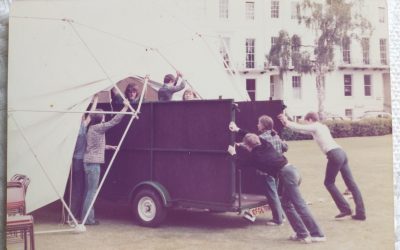It’s been a week for funny signs in shops. A friend texted me from the station to report seeing a sign in a Marks and Spencer’s Food store: ‘Takeaway bananas’. We have been musing over the idea of a non-take-away banana.
Meanwhile, down by the nuts and snacks in our local supermarket the other day, I was intrigued to see an aisle labelled ‘Single Crisps’. I knew we were in the midst of austerity cuts, but I didn’t realise that people were buying single crisps. Whatever next? A drop of water in a tiny plastic capsule, to go with your crisp?




… and there’s a hairdresser near me that offers “haircuts whilst you wait.”
Yours is a very minimalist blog, both in theme and treatment. I was hoping to discover the various preferences of the Florestan Trio regarding crisp flavours or something of vaguely musical relevance but, alas, no.
Talking of minimalism, could you recommend a recording of John Cage’s 4’33”? There are currently 24 available, but unfortunately not one by Glen Gould, whose ambient noise has always delighted me. Do you ever use this piece as an encore?
Well, David, I suppose the most appropriate answer to your question about John Cage’s piece 4’33” would be a few seconds of informative silence, so here they are: ” “.
Cage’s 4’33” got me thinking about the possibility of a piano recital where the pianist does anything but play the piano. Any ideas for the programme? My contribution is Anaparastasis lll (The Pianist) (1968) by Jani Christou. [Christou is a much acclaimed Gteek composer who died tragically young in a car accident – he merits a fairly lengthy mention in Groves’s, for example] The notes on this piece on my CD of it read:
“it cuts deep into the most primitive and universal fears of mankind – the inability to communicate. The work unfolds against an increasing continuum of electronic threads of sound which inform the psychodrama throughout. Stage directions and lighting are notated precisely. The pianist enters the stage in darkness and in a trance-like state and walks slowly to the piano. The volume of the music increases as does the srage lighting. After several abortive attempts to communicate with the piano in a traditional manner the pianist utters a terrible scream and becomes motionless. He tries again to communicate with the piano, this time crawling around underneath the piano, caressing and kissing it. Ensemble and tapes reach a terrifying climax. The pianist, now standing, faces the audience in apologetic manner. He gazes into the audience as if hypnotizrd. The music subsides. The continuum thread hangs in the air – there is no resolution.”
Do you have any suggestions for other similar items? It would make an interesting programme, don’t you think? Even one I could undertake.
Here in Paris some shops have bilingual signs. A grocer’s shop in the 18th arrondissement advertises “stranger wines”. Stranger than what? one wonders. Of course he meant ‘foreign wines’ and foreign in French does mean the same as a stranger.
Re David Wilson’s comment I remember a lovely piece for piano solo by Stephen Montague, played many years ago at the Purcell Room, where the pianist plays everything apart from the keyboard; the piano legs, the lid, the sides of the instrument, the stool with, if my memory is correst, an occasional direct pluck at the strings. It needs a Steinway.
Re Steve’s comment. Do you remember the name of the piece? Any more suggestions? We will soon have enough pieces for a full programme.
Re David’s request I managed to dig up the programme. The piece by Stephen Montague is “After Ives…” and was commissioned by Philip Mead who played it at the concert I mentioned in 1993. There is also a version with added flute/piccolo, string quartet & electronics.
How kind, Steve. I’m sure that someone MUST have written a piece which involves the destruction of a piano, which would be an appropriate final item for the programme.
Are you John Cage fans aware of the web campaign to make his 4’33” the Christmas no. 1? Libby Brooks mentions it in today’s Guardian:
http://www.guardian.co.uk/commentisfree/2010/nov/11/transfiguring-qualities-of-silence-and-solitude
How interesting, Susan. But which performance of it? That’s the crucial question. I noticed that the poet Ian Macmillan chose it recently on Desert Island Discs, but they played a disappointingly insipid version, by a trio if I remember correctly – it couldn’t have been the Florestan obviously. I seem to remember it was some wind band, but could be mistaken. In a recent number of the TLS there was a review of a new book from Yale devoted entirely to the piece and the review gave the performance details of David Tudor’s premiere and Cage’s detailed description of the ambient noise then. It was in this review that I came across the information that the most recent discography has 24 versions. So which one is the definitive one. Maybe Radio 3’s Building a Library should address this.
Correction. It was Ian McMillan (sorry for getting his name wrong) and the version they played was by the Amadinda Percussion Group, recorded on Hungaroton. It was also the disc he chose as his favourite of the eight. Though Cage specified that the piece could be played on any instrument or combination of instruments, I am afraid I’m a purist and believe the piano version is the definitive one.